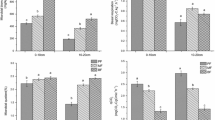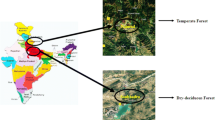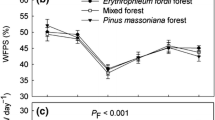Abstract
The vegetation community succession influences soil nutrient cycling, and this process is mediated by soil microorganisms in the forest ecosystem. A degraded succession series of karst forests were chosen in which vegetation community changed from deciduous broadleaved trees (FO) toward shrubs (SH), and shrubs–grasses (SHG) in the southwest China. Soil organic carbon (SOC), total nitrogen (TN), labile organic carbon (LOC), water extractable organic matter (WEOM), microbial biomass carbon and nitrogen (MBC and MBN), bacterial and fungal diversity, as well as soil enzyme activities were tested. The results showed that SOC, LOC, MBC, MBN, and enzyme activities declined with vegetation succession, with the relatively stronger decrease of microbial biomass and functions, whereas WEOM was higher in SHG than in other systems. In addition, soil bacterial and fungal composition in FO was different from both SH and SHG. Despite positive relationship with SOC, LOC, and TN (p < 0.01), MBC, MBN appeared to be more significantly correlated to LOC than to SOC. It suggested that vegetation conversion resulted in significant changes in carbon fractions and bioavailability, furthermore, caused the change in soil microbial community and function in the forest ecosystem.




Similar content being viewed by others
References
Baker MA, Valett HM, Dahm CN (2000) Organic carbon supply and metabolism in a shallow groundwater ecosystem. Ecology 81:3133–3148
Balser TC, Firestone MK (2005) Linking microbial community composition and soil processes in two California ecosystems. Biogeochemistry 73:395–415
Bassam BJ, Caetano-Anollés G, Gresshoff PM (1991) Fast and sensitive silver staining of DNA in polyacrylamide gels. Anal Biochem 196:80–83
Bastida F, Moreno JL, Hernández T, García C (2006) Microbiological activity in a soil 15 years after its devegetation. Soil Biol Biochem 38:2503–2507
Baum C, Fienemann M, Glatzel S, Gleixner G (2009) Overstory-specific effects of litter fall on the microbial carbon turnover in a mature deciduous forest. For Ecol Manag 258:109–114
Boyer JN, Groffman PM (1996) Bioavailability of water extractable organic carbon fractions in forest and agricultural soil profiles. Soil Biol Biochem 28:783–790
Brodie E, Edwards S, Clipson N (2003) Soil fungal community structure in a temperate upland grassland soil. FEMS Microbiol Ecol 45:105–114
Burford JR, Bremner JM (1975) Relationships between the denitrification capacities of soils and total, water-soluble and readily decomposable soil organic matter. Soil Biol Biochem 7:389–394
Caldwell BA, Griffiths RP, Sollins P (1999) Soil enzyme response to vegetation disturbance in two lowland Costa Rican soils. Soil Biol Biochem 31:1603–1608
Carney KM, Matson PA (2005) Plant communities, soil microorganisms, and soil carbon cycling: does altering the world belowground matter to ecosystem functioning? Ecosystems 8:928–940
Du YX, Pan GX, Li LQ, Hu ZL, Wang XZ (2010) Leaf N:P ratio and nutrient reuse between dominant species and stands: predicting phosphorus deficiencies in Karst ecosystems, southwestern China. Environ Earth Sci 64:299–309
Gianfreda L, Bollag JM (1994) Effect of soils on the behavior of immobilized enzymes. Soil Sci Soc Am J 58:1672–1681
Gloria R, Miren O, Ibone A, Iker M, Carlos G (2008) Relationship between vegetation diversity and soil functional diversity in native mixed-oak forests. Soil Biol Biochem 40:49–60
Grandy AS, Neff JC, Weintraub MN (2007) Carbon structure and enzyme activities in alpine and forest ecosystems. Soil Biol Biochem 39:2701–2711
Haynes RJ (1999) Size and activity of the soil microbial biomass under grass and arable management. Biol Fertil Soils 30:210–216
Hooper DU, Bignell DE, Brown VK, Brussaard L, Dangerfield JM, Wall DH (2000) Interactions between aboveground and belowground biodiversity in terrestrial ecosystems: patterns, mechanisms, and feedbacks. Bioscience 50:1049–1061
Hu S, Coleman DC, Carroll CR, Hendrix PF, Beare MH (1997) Labile soil carbon pools in subtropical forest and agricultural ecosystems as influenced by management practices and vegetation types. Agric Ecosyst Environ 65:69–78
Hu ZL, Pan GX, Li LQ, Du YX, Wang XZ (2009) Changes in pools and heterogeneity of soil organic carbon, nitrogen and phosphorus under different vegetation types in Karst mountainous area of central Guizhou Province, China. Acta Ecol Sin 8:103–109 (in Chinese)
Lagomarsino A, Moscatelli MC, Angelis P, De Grego S (2006) Labile substrates quality as the main driving force of microbial mineralization activity in a poplar plantation soil under elevated CO2 and nitrogen fertilization. Sci Total Environ 372:256–265
Loginow W, Wisniewski W, Gonet SS, Ciescinska B (1987) Fractionation of organic carbon based on susceptibility to oxidation. Pol J Soil Sci 20:47–52
Lundquist EJ, Jackson LE, Scow KW (1999) Wet-dry cycles affect dissolved organic carbon in two California agricultural soils. Soil Biol Biochem 31:1031–1038
Masayuki U, Rota W, Teri CB, Kanehiro K (2008) Variations in the soil microbial community composition of a tropical montane forest ecosystem: does tree species matter? Soil Biol Biochem 40:2699–2702
May LA, Smiley B, Schmidt MG (2001) Comparative denaturing gradient gel electrophoresis analysis of fungal communities associated with whole plant corn silage. Can J Microbiol 47:829–841
Mona N, HÖgberg P, HÖgberg D, Myrold D (2007) Is microbial community composition in boreal forest soils determined by pH, C–N ratio, the trees, or all three? Oecologia 150:590–601
Myrold DD (1999) Transformations of nitrogen. In: Sylvia D, Fuhrmann J, Hartel P, Zuberer D (eds) Principles and applications of soil microbiology. Prentice Hall, New Jersey, pp 259–294
Nakatsu CH, Torsvik V, Øverås L (2000) Soil community analysis using of 16 s rdna polymerase chain reaction products. Soil Sci Soc Am J 64:1382–1388
Nannipieri P, Grego S, Ceccanti B (1990) Ecological significance of the biological activity in soil. In: Bollag J-M, Stotzky G (eds) Soil Biochemistry, vol 6. Marcel Dekker, New York, pp 293–355
Nannipieri P, Ascher J, Ceccherini MT, Landi L, Pietramellara G, Renellam G (2003) Microbial diversity and soil functions. Eur J Soil Sci 54:655–670
Nayak DR, Jagadeesh Bab Y, Adhya TK (2007) Long-term application of compost influences microbial biomass and enzyme activities in a tropical Aeric Endoaquept planted to rice under flooded condition. Soil Biol Biochem 39:1897–1906
Nishiyama M, Sumikawa Y, Gang Guan, Marumoto T (2001) Relationship between microbial biomass and extractable organic carbon content in volcanic and non-volcanic ash soil. Appl Soil Ecol 17:183–187
Øvreås L, Torsvik V (1998) Microbial diversity and community structure in two different agricultural soil communities. Microb Ecol 36:303–315
Pan GX, Cao JH (1999) Karstification in epikarst zone: the earth surface ecosystem processes taking soil as a medium-case of the Yaji karst experiment site, Guilin (in Chinese). Carsologica Sin 18:287–296
Qualls RG, Haines BL (1992) Biodegradability of dissolved organic matter in forest through fall, soil solution and stream water. Soil Sci Soc Am J 56:578–586
Quideau SA, Graham RC, Oh S-W, Hendrix PF, Wasylishen RE (2005) Leaf litter decomposition in a chaparral ecosystem, Southern California. Soil Biol Biochem 37:1988–1998
Schinner F, Von Mersi W (1990) Xylanase-, CM-cellulase- and invertase activity in soil: an improved method. Soil Biol Biochem 22:511–515
Sterner RW, Elser JJ (2002) Ecological stoichiometry: the biology of elements from molecules to the biosphere. Princeton University Press, Princeton, pp 308–311
Stockdale EA, Rees RM (1994) Relationships between biomass nitrogen and nitrogen extracted by other nitrogen availability methods. Soil Biol Biochem 26:1213–1220
Tabatabai MA, Bremner JM (1969) Use of p-nitrophenyl phosphate for assay of soil phosphatase activity. Soil Biol Biochem 1:301–307
Van Miegroet H, Boettinger JL, Baker MA, Nielsen J, Evans D, Stum A (2005) Soil carbon distribution and quality in a montane rangeland-forest mosaic in northern Utah. For Ecol Manag 220:284–299
Vance ED, Brookes PC, Jenkinson DS (1987) An extraction method for measuring soil microbial biomass-C. Soil Biol Biochem 19:703–707
Waldrop MP, Balser TC, Firestone MK (2000) Linking microbial community composition to function in a tropical soil. Soil Biol Biochem 32:1837–1846
Wang SJ (2003) The most serious eco-geologically environmental problem in Southwestern China Karst rocky desertification. Bull Mineral Petrol Geochem 22:120–126 (In Chinese)
Wardle DA (2005) How plant communities influence decomposer communities. In: Bardgett RD, Usher MB, Hopkins DW (eds) Biological diversity and function in soils. Cambridge University Press, New York, pp 119–138
Yimer F, Ledin S, Abdelkadir A (2006) Soil organic carbon and total nitrogen stocks as affected by topographic aspect and vegetation in the Bale Mountains, Ethiopia. Geoderma 135:335–344
Yuan DX (1997) Problem of environmental geology in karst mountainous region of southwestern China. Res Dev World Sci Technol 5:93–97 (In Chinese)
Zak DR, Holmes WE, White DC, Peacock AD, Tilman D (2003) Plant diversity, soil microbial communities and ecosystem function: are there any links? Ecology 84:2042–2050
Zsolnay A, Steindl H (1991) Geovariability and biodegradability of the water-extractable organic material in an agricultural soil. Soil Biol Biochem 23:1077–1082
Zuazo VHD, Pleguezuelo CRR (2008) Soil-erosion and runoff prevention by plant covers: a review. Agron Sustain Dev 28:65–86
Acknowledgments
This study was supported by the National Key Basic Research Development Foundation of China (No. 2006CB403205).
Author information
Authors and Affiliations
Corresponding author
Rights and permissions
About this article
Cite this article
Li, L., Wang, D., Liu, X. et al. Soil organic carbon fractions and microbial community and functions under changes in vegetation: a case of vegetation succession in karst forest. Environ Earth Sci 71, 3727–3735 (2014). https://doi.org/10.1007/s12665-013-2767-3
Received:
Accepted:
Published:
Issue Date:
DOI: https://doi.org/10.1007/s12665-013-2767-3




